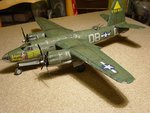I've been building the Hasegawa B-26 Marauder in 1/72 scale. I'm the type of guy that likes aircraft to have their landing gear retracted, and pilot figures in place. It's obvious how the pilot fits in the plane, but I wonder about the tail gunner. Where exactly did he sit - behind a bulkhead wall with his head directly below the tail fin? Was he on his knees or did he actually sit in a seat? His head was not seen through the canopy that's directly above the machine guns?
I would appreciate any input on this.
I would appreciate any input on this.


